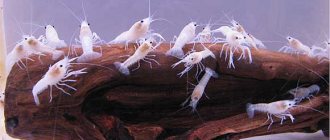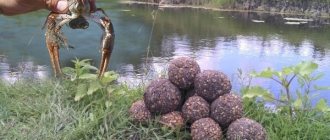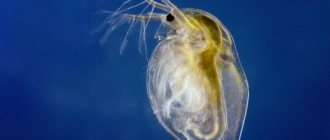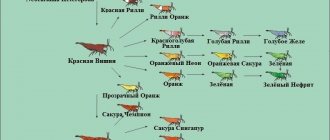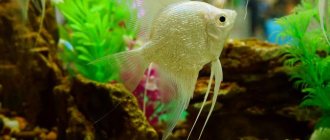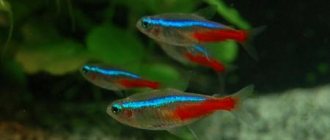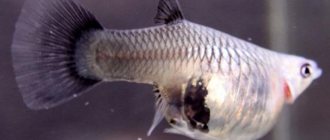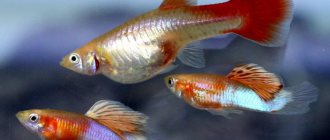Bulgur Mistral, 5 kg
651 ₽ More details
Bulgur Mistral, 5 kg
651 ₽ More details
Meat soups
Cancers are considered interesting and extraordinary creatures. People try to breed them at home for various reasons. Some - to diversify the domestic fauna with unusual pets, others - to decorate their menu, since their meat is considered a healthy delicacy. Crayfish begin to reproduce with the arrival of spring. Breeding them at home does not take much effort and does not require large financial investments, but it does take a lot of time.
Crayfish begin to reproduce with the arrival of spring
Breeding offspring
Fertility depends on the number of individuals of different sexes. Males and females have some differences, which make it possible to maintain their optimal ratio without much difficulty.
Males are larger in size than females in the same age category. They also differ in the location of the genital openings: in females they are located at the third pair of paws, and in representatives of the opposite sex - near the fifth pair. On the tail, immediately behind the paws, river armadillos have abdominal legs. In males, the first two pairs are well developed, but in females they are only a soft appendage or not at all.
Male crayfish are larger in size than females in the same age category
When mating, the crayfish wraps its legs around the female and presses tightly to her inner side. The sperm is transfused into the female and the eggs are fertilized. During mating, the female actively fights off the male’s grasp. After fertilization, she loses strength due to her active resistance. Worn out, she hides in a hole, crawling out in search of food during the daytime.
The male, on the contrary, remains active and is able to fertilize several more females. After several matings, he is exhausted and hungry. It happens that after the last intercourse he can eat his chosen one.
To avoid such consequences, the number of pets in the reservoir needs to be regulated - it must correspond to a 1:3 proportion.
Larval growth
It's interesting to watch how crayfish are born. After 18-20 days, the fertilized female begins to lay eggs, which stick to the stalks on the tail and remain there until the larvae appear. This period is the most difficult for the female. She constantly pushes oxygenated water, quickly straightening and tucking her tail to wash the eggs.
When a female stays in a hole for a long time, the water stagnates there, which can lead to the death of the eggs . They can also be damaged by small insects, such as water scorpions and smooth beetles.
Even with constant washing of eggs from mold, dirt and algae, some eggs come off, fall to the bottom and disappear. Of all the laid offspring, about sixty larvae are born, the length of which is 1.5 mm.
Of all the laid offspring, about sixty larvae are born.
At first they stay on the female's reach. After two weeks they begin to swim near her, and in case of any danger they immediately hide under her tail. Having gained a little strength, the babies leave the female and begin an independent life.
The larvae grow slowly . At three months, their length is 3 cm, and their appearance begins to correspond to adult individuals. After one year their length is 4 cm, after two years they grow to 6 cm.
To emerge from the egg, the crustacean breaks the shell with its legs and abdomen and hangs on the thread. After three days, the thread breaks, and the larva grabs the shell of the eggs or algae with sharp claws. So a small representative of crustaceans can live from 3 to 4 days, and during this time it feeds on the yolk, which is located in the yolk sac on the back under the shield.
https://youtube.com/watch?v=6bzLZQsYeas
Baby's first moult
Four days after birth, the larva has a soft shell. On the sixth day, the first molt in its life occurs: the yolk sac disappears, the shell hardens, and the larva eats the egg shell. After a week, the baby becomes very active and begins to swim near the female. At the age of two weeks, it can leave her forever and go to an independent life.
The molting period is very dangerous for crayfish . Not only the shell is shed, but also the covering of the gills, eyes, esophagus and teeth with which they eat food. Only gastroliths remain solid, which are located in the stomach and accumulate calcium necessary for the formation of solid parts of the body. A cancer that molts becomes defenseless, and therefore for almost the entire period it tries not to crawl out of its hole, so as not to become easy prey for predators or cannibalistic relatives.
To breed crayfish at home you will need an aquarium of at least 250 liters
How to cut crayfish
Having determined which parts are suitable for eating, you can move on to the cutting process itself. So, we answer the question of how to eat boiled crayfish :
- Separate the claws from the body, split and remove the meat part. If you are worried about the safety of your hands, you can use regular scissors.
- Examine the tail section for eggs. If there is one, it can be carefully removed with your lips or fingers. The ethics of eating crayfish are quite loyal to such manipulations.
- The broth stage has arrived. To get to it, you need to turn the arthropod on its back and open the shell.
- From the inside of the head, which opened after removing the shell, eat all the pulp with the orange mass. And scrape off the white mass from the shell (this is fat), you can also eat it.
- The gills also contain broth, which can be sucked out if desired.
- The last stage of cutting is to clean the neck from the chitinous cut. This is where the cancer has the most meat.
As you can see, there is nothing complicated in this process. The cutting sequence is very easy to remember. If you are afraid of confusing which parts are suitable for eating, use color as a guide. You can eat all meats that are white, pink or red in crayfish.
Breeding business
Arthropods are bred not only in natural reservoirs. An aquarium is one of the ways to reproduce crayfish.
These species are mainly bred at home:
- Blue Cuban. The species is popular for its fast growth and omnivorous nature. These crayfish mate at temperatures no higher than +26°C.
- The Australian crayfish is considered a meat species that is well bred in aquariums.
- Marbled crayfish is a hermaphrodite. When growing it, you need large spaces and constant water temperature.
Individuals for breeding can be purchased at supermarkets or caught yourself. The best option would be to purchase larvae. The volume of the aquarium will need to be at least 250 liters . Imitating the natural environment, stones, driftwood, and sand are placed on the bottom.
3 adult individuals are introduced into the aquarium to mate and produce young shoots. Their density in the container, so that they can reproduce, should not exceed 350 pieces per square meter.
Fishing methods
Due to the fact that today it is popular to catch crayfish with lines, few people use other fishing methods or even forget about them. But there are many options that are used to catch arthropods. Not all methods are easy enough, but this is what makes crayfish hunting so interesting and exciting.
Fishing with a crayfish
Catching crayfish by hand is prohibited by law, so it is recommended to use a crayfish catcher, which is quite easy to use. Typically, several types of crayfish traps are used simultaneously to increase the chance of catching crayfish. The design is made in such a way that arthropods get in there and cannot get out. And in order for them to get in there, they use bait that attracts crayfish.
Due to the fact that crayfish prefer to burrow in steep, steep banks to build burrows, the structure is installed near the coast. This is done like this:
- They take a long, strong stick, at one end of which there is a slingshot.
- The cord from the crayfish catcher is hooked with a slingshot so that the structure rises.
- The shell is slowly lowered into the water until it touches the bottom.
- The cord is tied to reeds, a stick stuck into the bank or any strong tree.
At night, crayfish come to the shore, so you should not throw the crayfish trap too far.
How to fish with a fishing rod?
This option is not easy, because crayfish are not fish, they just don’t bite the bait. Moreover, in the dark it will be difficult to attach the bait. For these reasons, there is only one way out - to catch crayfish with a fishing rod during daylight hours, but closer to sunset. It is recommended to choose a crawler, dung worm, rotten meat or fish as bait. The best time to catch crayfish with a fishing rod is from September to October.
It’s easier to catch crayfish with a classic fishing rod during the feeding season. For a larger catch, it is advisable to tie several hooks to the fishing rod at once, which will increase the likelihood that several crayfish will bite. Arthropods bite very slowly, but the crayfish will immediately feel the bite: the crayfish grabs the bait and drags it, while the float first moves smoothly to the side, and then sinks and hides in the water. Due to the fact that the crayfish does not cling to the bait very tightly, pull out the fishing rod carefully.
Screen efficiency
It is popular to catch crayfish with a screen, which is a round or square structure with sides that prevent the crayfish from falling out when removed from the water. For a good catch, 2-5 screens will be enough. The design of the screen is similar to a conventional clamshell, but differs in its rectangular shape.
They take steel wire, from which they make two squares, then they are fixed at a distance of 20-30 centimeters from each other, then they cover the bottom and side walls of the screen with mesh. Crayfish will crawl through the open top for bait. The screen is tied to a thick pole, which will act as a fishing rod, bait is placed in the center, and the screen itself is carefully placed in the water.
Care and feeding
Aquarium propagation of crayfish requires a lot of time. Raised in aquariums, they do not need to hibernate and gain weight much faster.
When breeding arthropods in aquariums, the following conditions must be observed :
- constant temperature;
- clean water supplied with oxygen;
- balanced food;
- mandatory vitamin supplementation.
Cancer is a herbivore, but under natural conditions its diet includes carrion. When there is a shortage of food, they devour their relatives.
In captivity, arthropods are fed boiled grain and potatoes, raw meat, grated carrots, fish, larvae of worms, insects, snails, and special foods. Under natural conditions, their diet includes greens, earthworms, snails, and small fish. With their claws, arthropods capture prey, tear off pieces from it and eat them.
Kinds
Osteogenic sarcoma of the leg
This type of leg cancer is a nonepithelial bone tumor.
The location of the leg sarcoma is very important:
- On the back of the lower leg;
- On the front of the shin.
Symptoms and development
If it is diagnosed on the back of the lower leg, it may not be noticeable for quite a long period, since it is hidden by the gastrocnemius major muscle.
If the cancer is on the front of the leg, then it is quite easy to diagnose its development and enlargement, due to changes in the condition of the skin above the tumor. It stretches and changes color.
Further from the lower leg, the sarcoma can spread to the fibula and tibia. This cancer can destroy the membranous connections between bones, causing frequent fractures.
In the first stages, pain does not occur with this disease. Only when the tumor grows does it put pressure on nearby nerves and vessels, causing pain. The pain spreads to the foot and toes, swelling appears, and trophic skin disorders may occur.
Soft tissue sarcoma of the leg
There are two types of soft tissue sarcoma of the leg:
- Superficial;
- Deep.
Symptoms and development
The first type of soft tissue cancer of the leg can be diagnosed in the early stages. The second one can be almost asymptomatic. There may be complaints of pain in the lower leg of a bursting and pulling nature.
As the disease progresses, its symptoms also intensify. Here are the main ones:
- Weakness without a specific reason;
- Anemia;
- Severe weight loss;
- Nausea;
- Lack of appetite;
- Fever.
Further, as it grows, the sarcoma presses on the vessels and nerves located in the foot area. Because of this, swelling of the feet and trophic ulcers appear, sensitivity in the toes worsens, and they begin to move worse.
Osteosarcoma
Simple homemade recipes
Despite the fact that the cost of red caviar is quite high, dishes with it are decorations for any holiday table. They look rich and appetizing.
The multi-layer salad is very tasty, sophisticated, but at the same time easy to prepare. To prepare you will need 4 boiled potatoes, 6 boiled eggs, 300 g of marinated or salted squid, 150 g of hard cheese and, of course, red caviar.
The calorie content of the chum salmon family product is the highest compared to other ingredients. First you need to grate cheese, potatoes, squid and eggs into different plates on a coarse grater.
Then lay out in layers. The first layer is squid, part of the eggs and caviar, coated with mayonnaise.
Then half the potatoes and our delicacy, mayonnaise, and then the second part of eggs, potatoes and cheese is laid out, and the top is decorated with red caviar. This is how you get a gorgeous multi-layer salad.
A snack made from our favorite product with eggs and crackers looks very original. To do this you will need 4 eggs, sprigs of fresh dill, 50 g of sour cream, a cracker and a large spoon of caviar.
Boiled eggs are cut crosswise into 6 even “wheels”, each piece is placed on a cracker, brushed with sour cream, caviar is spread on the sour cream and decorated with a sprig of dill on top.
Authorized Products
The diet should contain energy-intensive, easily digestible foods: grain bread, wholemeal bread, soups and cereals made from millet, unpolished or brown rice, buckwheat flakes, crispbread, boiled potatoes, red caviar, soy cheese, butter, various types of red fish, tuna, herring, liver, olive, sunflower and flax seed oil, soft-boiled eggs, milk and dairy products, sour cream, chocolate, cheeses.
Poultry (turkey, chicken) and rabbit meat must be included in the diet. Red meat - in small quantities, mainly veal or lean beef. It is important to have “soft” vegetables and salads based on them in the diet - carrots, zucchini, tomatoes, broccoli, cucumbers, cauliflower, beets, eggplants, asparagus, kohlrabi, herbs, wheat sprouts, kelp, as well as ripe fruits and berries ( pears, apricots, mangoes, tangerines, strawberries, peaches, peeled apples, melons, grapes, raspberries, bananas).
It is useful to include various nuts, dried fruits, honey and bee products in your diet. Dry and fortified wines, beer, and cognac can be added to the diet in small quantities. As for drinks, green and herbal tea and non-carbonated mineral water are extremely useful.
| Proteins, g | Fats, g | Carbohydrates, g | Calories, kcal | |
Vegetables and greens | ||||
| boiled cauliflower | 1,8 | 0,3 | 4,0 | 29 |
| boiled potatoes | 2,0 | 0,4 | 16,7 | 82 |
| boiled carrots | 0,8 | 0,3 | 5,0 | 25 |
| boiled beets | 1,8 | 0,0 | 10,8 | 49 |
Nuts and dried fruits | ||||
| nuts | 15,0 | 40,0 | 20,0 | 500 |
Cereals and porridges | ||||
| semolina porridge with milk | 3,0 | 3,2 | 15,3 | 98 |
| oatmeal with water | 3,0 | 1,7 | 15,0 | 88 |
| white boiled rice | 2,2 | 0,5 | 24,9 | 116 |
Flour and pasta | ||||
| noodles | 12,0 | 3,7 | 60,1 | 322 |
Bakery products | ||||
| white bread crackers | 11,2 | 1,4 | 72,2 | 331 |
Chocolate | ||||
| chocolate | 5,4 | 35,3 | 56,5 | 544 |
Raw materials and seasonings | ||||
| honey | 0,8 | 0,0 | 81,5 | 329 |
Dairy | ||||
| milk 3.2% | 2,9 | 3,2 | 4,7 | 59 |
| condensed milk | 7,2 | 8,5 | 56,0 | 320 |
| kefir 3.2% | 2,8 | 3,2 | 4,1 | 56 |
| cream 20% (medium fat content) | 2,8 | 20,0 | 3,7 | 205 |
| sour cream 25% (classic) | 2,6 | 25,0 | 2,5 | 248 |
| Ryazhenka | 2,8 | 4,0 | 4,2 | 67 |
Bird | ||||
| boiled chicken drumstick | 27,0 | 5,6 | 0,0 | 158 |
| boiled turkey fillet | 25,0 | 1,0 | – | 130 |
Eggs | ||||
| omelette | 9,6 | 15,4 | 1,9 | 184 |
| soft-boiled chicken eggs | 12,8 | 11,6 | 0,8 | 159 |
Fish and seafood | ||||
| boiled fish | 17,3 | 5,0 | 0,0 | 116 |
| pink salmon | 20,5 | 6,5 | 0,0 | 142 |
| Red caviar | 32,0 | 15,0 | 0,0 | 263 |
| cod roe | 24,0 | 0,2 | 0,0 | 115 |
| salmon | 19,8 | 6,3 | 0,0 | 142 |
| herring | 16,3 | 10,7 | – | 161 |
| cod (liver in oil) | 4,2 | 65,7 | 1,2 | 613 |
| trout | 19,2 | 2,1 | – | 97 |
Oils and fats | ||||
| vegetable oil | 0,0 | 99,0 | 0,0 | 899 |
| peasant unsalted butter | 1,0 | 72,5 | 1,4 | 662 |
| linseed oil | 0,0 | 99,8 | 0,0 | 898 |
Non-alcoholic drinks | ||||
| water | 0,0 | 0,0 | 0,0 | – |
| green tea | 0,0 | 0,0 | 0,0 | – |
Juices and compotes | ||||
| compote | 0,5 | 0,0 | 19,5 | 81 |
| juice | 0,3 | 0,1 | 9,2 | 40 |
| jelly | 0,2 | 0,0 | 16,7 | 68 |
| * data is per 100 g of product |
In the diet menu, it is necessary to limit red, especially fatty and fried meat (pork, bacon), as well as products made from it (sausages, smoked meats), cakes, butter creams, puddings. The consumption of vegetables that cause bloating is also reduced: beans, garlic, onions, lentils, peas, soybeans, coarse types of cabbage, red capsicum.
It is not recommended to eat hard-boiled eggs, salted, spicy and smoked foods, canned fish, and fresh bread made from wholemeal flour. The consumption of sour and unripe fruits, fruits with hard skin is limited: rhubarb, gooseberries, plums, grapefruit, oranges, lemons, currants. Highly carbonated drinks with preservatives, sour teas, and coffee made from over-roasted beans are excluded from the list of drinks.
| Proteins, g | Fats, g | Carbohydrates, g | Calories, kcal | |
Vegetables and greens | ||||
| canned vegetables | 1,5 | 0,2 | 5,5 | 30 |
| peas | 6,0 | 0,0 | 9,0 | 60 |
| white radish | 1,4 | 0,0 | 4,1 | 21 |
| celery (root) | 1,3 | 0,3 | 6,5 | 32 |
| beans | 7,8 | 0,5 | 21,5 | 123 |
| garlic | 6,5 | 0,5 | 29,9 | 143 |
Fruits | ||||
| grapefruit | 0,7 | 0,2 | 6,5 | 29 |
| lemons | 0,9 | 0,1 | 3,0 | 16 |
| plums | 0,8 | 0,3 | 9,6 | 42 |
Berries | ||||
| gooseberry | 0,7 | 0,2 | 12,0 | 43 |
| currant | 1,0 | 0,4 | 7,5 | 43 |
Mushrooms | ||||
| mushrooms | 3,5 | 2,0 | 2,5 | 30 |
Flour and pasta | ||||
| pasta | 10,4 | 1,1 | 69,7 | 337 |
| vareniki | 7,6 | 2,3 | 18,7 | 155 |
| dumplings | 11,9 | 12,4 | 29,0 | 275 |
Bakery products | ||||
| wheat bread | 8,1 | 1,0 | 48,8 | 242 |
Confectionery | ||||
| cookie | 7,5 | 11,8 | 74,9 | 417 |
Cakes | ||||
| cake | 4,4 | 23,4 | 45,2 | 407 |
Raw materials and seasonings | ||||
| seasonings | 7,0 | 1,9 | 26,0 | 149 |
| mayonnaise | 2,4 | 67,0 | 3,9 | 627 |
| sugar | 0,0 | 0,0 | 99,7 | 398 |
| salt | 0,0 | 0,0 | 0,0 | – |
Dairy | ||||
| cream 35% (fat) | 2,5 | 35,0 | 3,0 | 337 |
Meat products | ||||
| fatty pork | 11,4 | 49,3 | 0,0 | 489 |
| salo | 2,4 | 89,0 | 0,0 | 797 |
| beef | 18,9 | 19,4 | 0,0 | 187 |
| bacon | 23,0 | 45,0 | 0,0 | 500 |
Sausages | ||||
| smoked sausage | 9,9 | 63,2 | 0,3 | 608 |
Bird | ||||
| fried chicken | 26,0 | 12,0 | 0,0 | 210 |
Eggs | ||||
| hard-boiled chicken eggs | 12,9 | 11,6 | 0,8 | 160 |
Oils and fats | ||||
| rendered pork fat | 0,0 | 99,6 | 0,0 | 896 |
Non-alcoholic drinks | ||||
| black coffee | 0,2 | 0,0 | 0,3 | 2 |
| * data is per 100 g of product |
Soybeans and any products made from soy (tofu, tempeh, miso and soy sauce) prevent the proliferation of cancer cells. In addition, they contain isoflavones and phytoestrogens, which have antitumor activity. In addition, soy products reduce the toxic effects of radiation and chemotherapy.
Cooking
The smell, color and taste of finished crayfish depends on how well you wash them.
Step 1. First, the crayfish must be washed thoroughly. Pay special attention to the area under the abdomen. Rinse with a brush until clean water.
Step 2. Fill with water for 1 hour. We need to make sure that all crayfish are alive and active.
Step 3. Prepare all the necessary ingredients for the broth per 1 kg of crayfish: 1–1.3 liters of water:
- a bunch of dill;
- 3 bay leaves;
- 3 peas of allspice;
- 4 cloves of garlic;
- 1 generous tablespoon of salt.
You can take more water. Then increase the other ingredients of the broth accordingly.
Mix everything.
Step 4. When the water boils, check once again whether your crayfish are alive and active. Place them one at a time, preferably head down.
They don’t eat dead crayfish because they release toxins, since 10% of their diet consists of organic waste.
Step 5. Cook from the moment of boiling for 13–15 minutes, with the lid closed.
Step 6. 5 minutes before readiness, add 10-15 grams of butter to the broth.
Step 7. Leave for 15–20 minutes. The crayfish should be well salted and nourished.
Step 8. The crayfish are ready. Proceed to cutting and eating. Or you can wait until it cools down completely.
